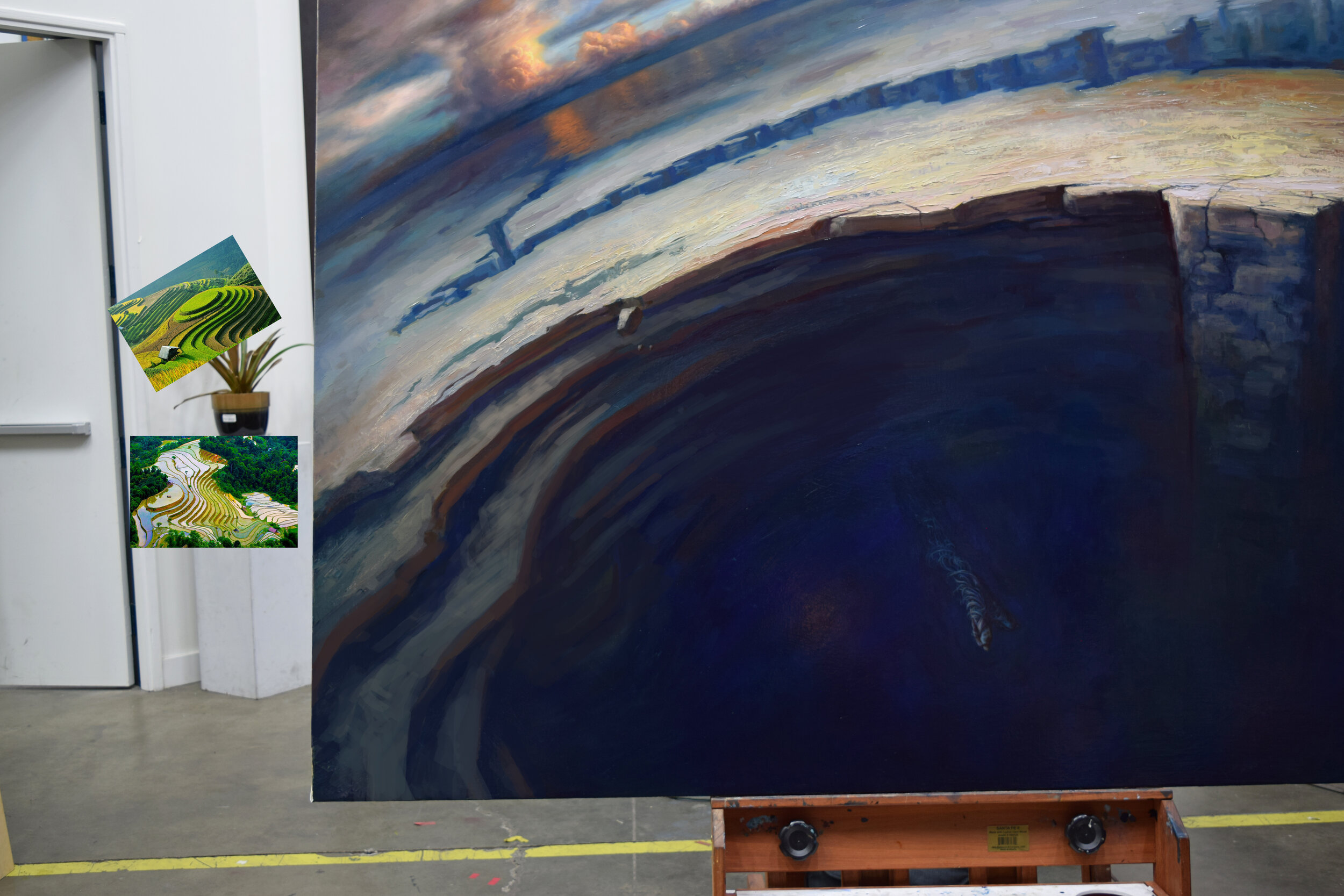The Development of Basin
See the development of ‘Anthesis’ for the initial stages of ‘Basin’, as they were originally conceived as the same composition
Figure/Landscape ‘Cell Division’
Scanning the drawing into Photoshop, I began experimenting with the figure/landscape relationship. I retrieved a reference of a quarry and noticed how it appeared like a spiraling canyon into the earth. I tried extending that spiral so it would further spread throughout the landscape. Finally, I attempted to carve the whole matter out, forming a massive circular abyss.
While I liked these new developments in the landscape, I was finding the surroundings increasingly separate from the figure. It felt as if the landscape sought to be its own creation. Given this awareness, I decided to divide the concept into two projects: The curved horizon landscape became ‘Basin’ and the figurative version ‘Anthesis’.
Falling Figures Idea
In a sense, the figures evolved their way out of Basin. Viewed in another way, the basin swallowed the figures into the composition such that only the landscape remained. In this iteration, I imagined figures falling from the sky like comets and seeding the basin. I ultimately felt that in this piece the landscape on its own was best, and that concept be used for a future painting.
Initial Mock-up
After removing all figures, I began filling in the missing areas, roughing in color, and ‘photo bashing’ various sky elements.
Finished Small Painting
Using the previous mock-up, I painted this 9 x 12 mini painting (which I decided to send to Abend Gallery for a small works show).
New Sky
After photographing the small painting, I turned to Photoshop and began experimenting with alternate versions of the sky. I was motivated by a sense that the piece needed another focal element in the upper left corner to facilitate compositional movement.
Attempted Return of the Falling Figures
I revisited the idea of the figures falling into the basin like comets, but this time as smaller elements. I liked this version, but it still felt like the piece was more visually impactful without them.
Figure Seed-Comet
The conceptual element of the ‘seed figure’ was intriguing but still needed re-working. Rather than multiple ‘figure comets’ falling, I decided to take a more minimalistic approach and reduce the figures from several to only one. This enabled me to still embed that concept into the piece without it being visually overbearing. I was then compelled to make the ‘ion tail’ of this figure comet more organic, more like a bundle of streaming DNA helixes.
Final Mock-Up
Steered from a sense of assurance with the mock-up, I was ready to move onto the large painting. Because I had designed this piece to fit the botched first canvas prepared for The Birth of Venus, my canvas was already prepared and ready to go.
The Transfer
As always, the transfer involved a lot of charcoal.
Sky First
In this painting, I began with the sky and essentially worked from ‘far to near’. I used a simple raw sienna tone for the underpainting.
New ‘Terraced’ Interior
At this stage of the painting, the interior of the basin appeared to need a more compelling draw. I turned to references of terraced mountains and was intrigued by those of rice fields in Japan. I took a photo of the painting and then made a digital paint-over. This was used to make the essential changes in the actual painting. View the slideshow below to see how the painting changes.
Basin at IX
While exhibiting Basin at IX, I received the most unexpected and finest type of compliment. I was behind my booth and out of view when a young fellow approached and made a kicking motion at the painting. He returned to his friends and pointed at the painting excitedly. I then understood what the kick meant. This was a reenactment of the scene in 300, when Lionadas yells, ‘This is Sparta’ and kicks the invader into the abyss.


